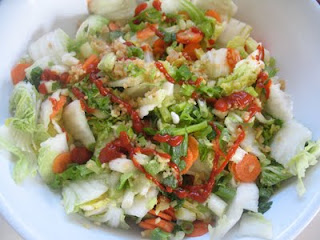Kimchee (also spelled kim chi or gimchi) is a spicy, fermented Korean vegetable dish, used as a side or garnish. It’s eaten with most meals in Korea, and I gather that when deprived of it for more than a few days, Koreans—and others who have gotten the kimchee bug—will suffer serious cravings and withdrawal.

So much so, that when the first Korean went into space some years back, the government resolved to send up some kimchee with him. Here is an excerpt from the New York Times article about the difficulties of creating “space kimchi”:
“If a Korean goes to space, kimchi must go there, too,” said Kim Sung Soo, a Korea Food Research Institute scientist...
After millions of dollars and years of research, South Korean scientists successfully engineered kimchi... for space travel...
“The key was how to make a bacteria-free kimchi while retaining its unique taste, color and texture,” said Lee Ju Woon at the Korean Atomic Energy Research Institute, who began working on the newfangled kimchi in 2003 with samples provided by his mother.
Ordinary kimchi is teeming with microbes, like lactic acid bacteria, which help fermentation. On Earth they are harmless, but scientists fear they could turn dangerous in space if cosmic rays cause them to mutate. Another problem is that kimchi has a short shelf life, especially when temperatures fluctuate rapidly, as they do in space.
“Imagine if a bag of kimchi starts fermenting and bubbling out of control and bursts all over the sensitive equipment of the spaceship,” Lee said.
Lee’s team found a way to kill the bacteria with radiation while retaining 90 percent of the original taste.
Now, I don’t have any particular craving for kimchee, but I do quite enjoy it. So I've taken to making it at home--and it's truly easy to make (recipe with amounts at end of post):
Cut up a half a head of Napa cabbage into one-inch squares, sprinkle it with salt, put it into a large bowl, and cover it with cold water.

Next, add two thinly sliced two carrots,

and then weigh down the veg with a plate and heavy bowl, and put this in the fridge overnight.

The next day, rinse off the cabbage and carrots, and put them back in the bowl.

Now for the other flavor-ingredients: Chop up garlic, ginger and green onions.

In addition, you add red pepper flakes or hot chili sauce (I used Sriracha, which we call “rooster sauce”) and sugar:

These get mixed into the vegetables,

and then the whole thing is transferred into a glass jar (in this case, a large pickle jar).

Press down the vegetables with your hand, and add enough cold water to cover them:
Let the jar sit out on the counter for two or three days, to ferment. I generally let mine go for three days, then taste it to see if it needs more fermenting. (Note that refrigeration slows the fermentation process, but as the kimchee is still alive, it will continue to ferment.)

Kimchee
½ large head Napa/Chinese cabbage, cut into 1” pieces
2 carrots, thinly sliced
4 T salt
enough water to cover the veg
2 T garlic, finely chopped
2 T fresh ginger, finely chopped
2 green onions, coarsely chopped
4 T sugar
1-2 T hot chili sauce, or 1 t red pepper flakes (use more or less, depending on how spicy you like your food)
1 T fish sauce (optional)
Place the cabbage and carrots in a bowl, and sprinkle with the salt. Add water to cover, and mix well. Weigh the veg down with a plate or bowl, and put in fridge overnight.
The next day, rinse the cabbage and carrots with cold water, and put them back in the bowl. Add all the other ingredients, and mix well.
Transfer it all to a large glass jar, press it down with your hands, and then add enough cold water to cover the vegetables. (Make sure to leave an inch or two of space at the top of the jar, to allow room for the gas that will be created during fermentation.) Let the jar sit at room temperature for two to three days.
Once fermented, store it in the fridge. It will continue to ferment slowly in the refrigerator, becoming increasingly sour and flavorful. As long as you use clean utensils to take out small portions, it should keep for several months in the fridge.
🌱 🍜 🌿
The daughter of a law professor and a potter, Leslie Karst learned early, during family dinner conversations, the value of both careful analysis and the arts—ideal ingredients for a mystery story. Putting this early education to good use, she now writes the Lefty Award-nominated Sally Solari Mysteries, a culinary series set in Santa Cruz, California.
An ex-lawyer like her sleuth, Leslie also has degrees in English literature and the culinary arts. She and her wife and their Jack Russell mix split their time between Santa Cruz and Hilo, Hawai‘i.
Leslie’s website
Leslie also blogs with Chicks on the Case
Leslie on Facebook
Leslie on Twitter
Leslie on Instagram
Praise for Leslie's most recent Sally Solari mystery, the Lefty Award-nominated MURDER FROM SCRATCH:
“Karst seasons her writing with an accurate insider’s view of restaurant operation, as well as a tenderness in the way she treats family, death and Sally’s reactions to Evelyn’s blindness.”
Ellery Queen Magazine (featured pick)
All four Sally Solari Mysteries are available through Amazon, Barnes and Noble, and Bookshop.
Dying for a Taste, A Measure of Murder, and Murder from Scratch are also available as AUDIOBOOKS from Audible!












.png)































Thank you for this recipe, Leslie! We've been eating and loving kimchee since our sons were little guys - but we've never made it. That is changing now.
ReplyDeleteThat's terrific, Molly! I felt the same way when I realized how easy it was to make.
DeleteMaking yourself means you get to decide how spicy it will be.
ReplyDeleteThat could make a big difference for the less spicey loving of us.
So true, Libby!
DeleteThanks for the recipe - everyone in the family loves kimchee! We've tried quite a few brands - there's a vendor at the farmers market that sells four different types.
ReplyDeleteIt can definitely become addictive!
DeleteI learned to eat kimchee as a bar snack in Japan. Must make my own now!
ReplyDelete